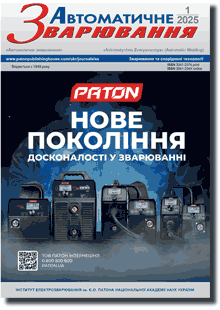Access for download PDF files for subscribers and for reviewers of scientometric bases.
Organization: Elsevier for content access(PDF files of journals released before 2024 are available for download from the website's archives))
Organization: Elsevier for content access(PDF files of journals released before 2024 are available for download from the website's archives))
| 2025 №01 (06) |
DOI of Article 10.37434/as2025.01.07 |
2025 №01 (08) |

"Avtomatychne Zvaryuvannya" (Automatic Welding), #1, 2024, pp. 45-49
Movement systems for arc additive manufacturing based on typical equipment
S.M. Minakov1, A.S. Minakov1, D.V. Stepanov1, Ye.P. Chvertko1, N.M. Strelenko1, D.M. Vdovychenko2, I.M. Vdovychenko2
1National Technical University of Ukraine «Igor Sikorsky Kyiv Polytechnic Institute». 37 Beresteyskyi Ave., 03056, Kyiv, Ukraine2E.O. Paton Electric Welding Institute of the NAS of Ukraine 11 Kazymyr Malevych Str., 03150, Kyiv, Ukraine. E-mail: maksimov@paton.kiev.ua
Wire-arc additive manufacturing is becoming widespread in industry due to the high productivity of forming the parts and the ability to build units using traditional welding equipment, such as power sources, wire feeders, gas supply systems, and torches. However, the problems associated with the mandatory need for additional machining of parts produced by arc additive surfacing methods, which, in turn, is caused by residual stresses and deformations in the part and significant surface roughness, remain relevant today. In addition to technological solutions, optimization of part forming processes requires solving a number of problems related to movement of the product and the welding tool during production. In general, such movements need to be performed in a multi-axis coordinate system and with sufficiently high accuracy, while the total movement may be a combined movement of the product and the tool. This paper describes in detail the process of developing multi-axis motion systems for arc additive surfacing units. In contrast to the use of robotic systems as manipulators, the units were built on the basis of universal equipment, which allowed significantly reducing its cost. The parameters required to perform the tasks of arc additive surfacing in shielding gases were achieved as a result of designing equipment that has been successfully tested for additive surfacing of web and flange parts. 6 Ref., 7 Fig.
Keywords: welding, additive manufacturing, wire-arc additive manufacturing, MAG surfacing, unit
Received: 21.10.2024
Received in revised form: 20.12.2024
Accepted: 19.02.2025
References
1. Ryabtsev, I., Fomichov, S., Kuznetsov, V. et al. (2023) Surfacing and Additive Technologies in Welded Fabrication. Springer Nature. https://doi.org/10.1007/978-3-031-34390-22. Knezović, N., Topić, A. (2018) Wire and arc additive manufacturing (WAAM) - a new advance in manufacturing. Lecture Notes in Networks and Systems, 42, 65-71. https://doi.org/10.1007/978-3-319-90893-9_7
3. Ding, D., Pan, Z., Cuiuri, D., Li, H. (2015) Process planning strategy for wire and arc additive manufacturing. Advances in Intelligent Systems and Computing, SpringerLink, 363, 437-450. https://doi.org/10.1007/978-3-319-18997-0_37
4. Kvasnytskyi, V., Lagodzinskyi, I. (2023) Influence of GMAW and PAW methods of additive arc surfacing and shielding gas composition on surface geometry and metal structure. The Paton Welding J., 11, 21-29. https://doi.org/10.37434/tpwj2023.11.02
5. Yehorov, Y., da Silva, L.J., Scotti, A. (2019) Balancing WAAM production costs and wall surface quality through parameter selection: A case study of an Al-Mg5 alloy multilayernon-oscillated single pass wall. J. of Manufacturing and Materials Processing, 3(2), 32. https://doi.org/10.3390/jmmp3020032
6. Wu, B., Pan, Z., Ding, D. et al. (2018) A review of the wire arc additive manufacturing of metals: Properties, defects and quality improvement. J. of Manufacturing Processes, 35, 127-139. https://doi.org/10.1016/j.jmapro.2018.08.001
Advertising in this issue:
To order the electronic version of the paper:
S.M. Minakov, A.S. Minakov, D.V. Stepanov, Ye.P. Chvertko, N.M. Strelenko, D.M. Vdovychenko, I.M. VdovychenkoMovement systems for arc additive manufacturing based on typical equipment
Automatic Welding №01 2025 p.45-49
The cost of article (pdf): 13 $, 12 €, 150 UAH (1 copy. )
fill in the form below:
The cost of subscription/purchase order journals or individual articles
| Journal/Currency | Annual Set | 1 issue printed |
1 issue |
one article |
| TPWJ/USD | 384 $ | 32 $ | 26 $ | 13 $ |
| TPWJ/EUR | 348 € | 29 € | 24 € | 12 € |
| TPWJ/UAH | 7200 UAH | 600 UAH | 600 UAH | 280 UAH |
| AS/UAH | 1800 UAH | 300 UAH | 300 UAH | 150 UAH |
| AS/USD | 192 $ | 32 $ | 26 $ | 13 $ |
| AS/EUR | 180 € | 30 € | 25 € | 12 € |
| SEM/UAH | 1200 UAH | 300 UAH | 300 UAH | 150 UAH |
| SEM/USD | 128 $ | 32 $ | 26 $ | 13 $ |
| SEM/EUR | 120 € | 30 € | 25 € | 12 € |
| TDNK/UAH | 1200 UAH | 300 UAH | 300 UAH | 150 UAH |
| TDNK/USD | 128 $ | 32 $ | 26 $ | 13 $ |
| TDNK/EUR | 120 € | 30 € | 25 € | 15 € |
AS = «Automatic Welding» - 6 issues per year;
TPWJ = «PATON WELDING JOURNAL» - 12 issues per year;
SEM = «Electrometallurgy Today» - 4 issues per year;
TDNK = «Technical Diagnostics and Non-Destructive Testing» - 4 issues per year.









